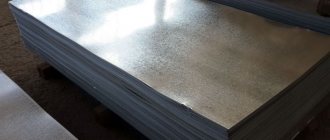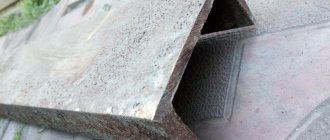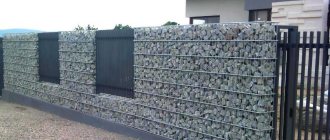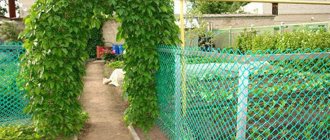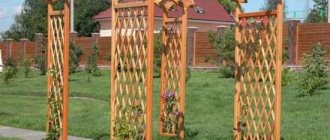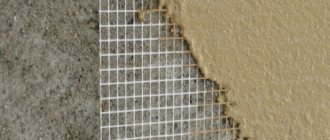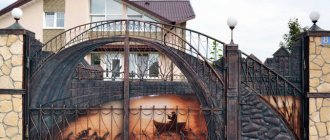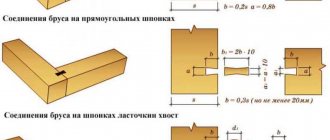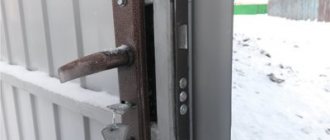Gabions are structures made of a metal mesh frame filled with various materials. If in former times they were widely used by military people for protection from enemies, now the structures have a different purpose. With the help of gabions, they strengthen the banks of reservoirs, the slopes of embankments and hills. Their aesthetic appeal is of no small importance.
From the battlefield to the estates. History of gabions
As you know, many things appeared thanks to, if it is appropriate to say so, wars. Canisters, for example, microwave ovens, adhesive tape or canned food, which Napoleon ordered technologists to invent. The history of gabions is also connected with the French emperor. He widely used tall, bottomless baskets to protect trenches and guns. In Rus', such mobile structures were called tours, and in Europe, gabions, from the Italian word meaning “large cage.”
Gabions are still used in military affairs. But, starting from the end of the century before last, more and more in engineering. Lightweight, mobile, but durable, gabions, as practice has shown, perfectly strengthen slopes, banks, and areas at risk from the point of view of possible landslides.
In recent years, gabion structures have become very popular among “green” architects and landscape designers.
Geotextiles
In the past, sand or crushed stone was used, but now geotextiles are used as a return filter. This reduced the amount of sand consumed by 20%.
Geotextile fabric has many advantages:
- Waterproof
- Not subject to rotting
- Prevents mold growth
- Good at protecting against rodents
Typically, geotextiles are used in rolls, and when laying it there must be an overlap of at least 10cm-20cm and then the edges must be glued or stitched.
Basic types of gabion products
There are, in fact, three main varieties: gabions are box-shaped, cylindrical and mattress-mattress (in other words, Reno mattresses).
The first, in the form of parallelepipeds, are to strengthen steep banks, slopes, walls, and make high fences from them. The latter are presented in the form of cylindrical baskets, more suitable for creating decorative accessories - columns, columns and the like.
Third, they line flat areas and fix the bottoms of reservoirs. These are the basic types of gabions, but of course there are more variations: cubic, spherical, conical...
Gabions can be of almost any shape, with any filling, which makes these structures especially attractive in the eyes of landscape design specialists.
Mattresses or mattresses
This is the name given to flat frames whose height is no more than 30 cm. They are shaped like spring mattresses for beds, which is why they got this name. They are used to strengthen the soil on gentle slopes, as well as for laying the beds of canals and rivers.
The mattresses are laid closely on the slope, connected to each other and secured to the ground with long anchors. A thin layer of fertile soil is poured on top and grass is sown. After some time, the roots of the grass cover penetrate between the stones, serving as additional fastening material. Such a slope will not crumble and will not require repairs or renovations for many decades.
Advantages and disadvantages of gabions
Mesh cells have quite a lot of advantages, among them:
- Durability . Typically, the gabion frame consists of very strong, double-twisted wire and reinforcement.
- Durability . Gabion products do not crack, tear, break under loads, or deform when the soil settles.
- Flexibility . Thanks to the wire structure, the “big cages” tolerate soil erosion without problems, even if it occurs at the base of the structure.
- Moisture resistance . Gabions absorb water without being destroyed. This quality is especially valuable if the site is located in the so-called erosion zone. Gabions are also irreplaceable when additional drainage is required.
- Air permeability . Giving the impression of a blank, monolithic fence, gabions nevertheless allow air to pass through well.
- Environmental friendliness . Everything that has the prefix “eco” is in fashion, and gabions are an example of naturalness.
- Aesthetics . Gabions have a bold, textured, always neat appearance.
- Affordability . Gabions are significantly cheaper than their concrete counterparts and are easy to use.
Do they have any disadvantages? Many consider the disadvantage to be the difficulty of installing large and tall gabion sections. In this case, specialists are hired for installation.
Materials for making boxes
Today it is not difficult to purchase ready-made boxes for gabions made of mesh and steel bars, but in order to save money, as well as to produce structures of unique shapes and sizes, it is worth trying to make them yourself. For this you will need:
- reinforcing rolled or sheet welded mesh;
- reinforcing bars for the manufacture of a rigid frame and anchors securing the structure in the ground;
- steel wire for fastening gabions together;
- paint to protect metal from corrosion.
Streck mesh reinforcement cell 10x10mm, 1x10m roll=10m2
In addition, you will need pliers to bend the wire and wire cutters to cut it, as well as metal cutting scissors to cut the rolled mesh. To create products of complex shapes, you need a welding machine and, of course, at least minimal ability to weld metal. It will be very good if you have a stapler for working with thick staples, which will significantly simplify the process of fastening mesh parts together. If you don’t have this tool, it doesn’t matter: wind the wire around a thin tube to create something like a spring, then use it to twist the parts.
The gabion mesh must be strong to support the weight of the stones. This is especially important if you plan to install large jumbo boxes over a meter high on your site. The mesh thickness and other characteristics are given in a special document - GOST R52132-2003. Please note that the gabion parameters indicated in it are designed for the construction of large-scale hydraulic structures.
When making small structures for a private farmstead, the strength requirements will be much less stringent. The wire diameter can remain within 2.5-3 mm. The wire for twisting individual parts into a single structure must be the same diameter as the wire for the mesh. To ensure that decorative gabions retain their presentable appearance for as long as possible, the frame is made of galvanized wire, or better yet, of polymer-coated wire. If you cannot find a suitable material, after assembling the box, you can paint it yourself in any color of your choice.
Wire 0.8mm 50m copper
Where are gabions used?
The scope of application of mesh containers is quite extensive. We list the most popular options for using gabions in landscape design:
— Terracing . Gabions will save the unfavorable terrain. With their help, you can straighten and level a platform located at an angle, creating a multi-stage terrace.
— Retaining walls . Boxes filled with stones, wooden blocks or saw cuts are in amazing harmony with lush greenery and flowers. And if you add a canopy or arch to this symbiosis, you will get a secluded, shady gazebo.
— Fences and enclosures . Gabions, combining various fillers, can surround the entire estate. Or cover outbuildings or cover the compost pit. Both the entire fence and, for example, its basement part are built from gabions. Then wooden panels or boxes with vegetation are attached to this base.
You can alternate hedges and gabions: a beautiful bush, next to a mesh section and again a bush. Where large fences are undesirable, low barriers and even borders are made from gabions. The field for creativity, “play”, and configurations is so wide that a separate term has appeared - pergons. So, they call the same bulk walls and partitions, the function of which is to zone and decorate the site. The pergons make it both colorful and neat at the same time.
Fences made of gabions and pergons - photos
— Reservoirs . The bottom is strengthened with mattress gabions, and the banks with box-shaped gabions. Experts especially recommend finishing the reservoir with gabions if the soil on the site is too wet and requires improvement of the drainage system.
At the same time, please note that the shape of the reservoir can be any, and gabions can become not only a successful engineering solution, but also a beautiful finish for the reservoir. Form them into sides, and an ordinary pond will be transformed into a noble pool.
— Outdoor fireplaces , hearths, barbecues can also be made of durable boxes filled with fire-resistant stones.
— It’s quite possible to make garden furniture, benches and tables from small gabions.
Such items are made by combining various fillers or the gabions themselves with other materials - ceramic tiles, tempered glass, wood. For example, a compact pile of light stones, fastened with a mesh and covered with glass, easily turns into a tea table. A larger wooden tabletop on a gabion becomes a dining table. You can even make a garden version of a bar counter from gabions.
- Rock garden - and it can be made by resorting to a mesh structure. Such an alpine slide will not “creep”, maintaining a somewhat strict but effective appearance.
Gabions, in addition, accent flower beds, frame stairs and paths, individual trees, and form them into columns, arches, stands for garden lanterns, urns and flower vases, abstract figures and even sculptures...
Gabions are an unusually versatile and flexible building and design material. This property is imparted to them not only by their flexible design, but also by their filling. After all, the “filling” of cellular boxes can be very different!
Which gabion filler is right for you?
The stone for gabions is selected depending on the location (overwater or underwater) of the structure being erected. Both natural and artificial stones of coarse crushing are used. This takes into account their shape, size, and composition. The most popular are hard rocks of volcanic origin: basalt, quartzite, granite, diorite. Gabions are often filled with sandstone, as well as other rocky rocks that are characterized by high frost resistance and strength. Gabions used for decorative purposes can be filled with alternative materials: wooden cuts, pieces of pipes, glass, broken tiles, bricks, paving stones, crushed concrete, etc.
The type, shape, size, as well as the color of the stone filler used, influence the decorative qualities of the gabion structure
When arranging above-water gabions, it is recommended to fill in stone, the size of the fractions of which is one third greater than the length of the cell of the twisted mesh. Underwater structures are filled with even larger stones, half the size of the mesh container cell.
In order for gabion structures to blend into the local landscape, it is necessary to use natural stone extracted from local quarries for filling. Gabions are laid out with rounded boulders, crushed stone, and large pebbles. In each case, the structure will look beautiful in its own way.
Important! To highlight the gabions on the site and emphasize the special texture of their walls, it is recommended to lay asphalt next to them or lay out a lawn. Against the background of a flat surface, containers filled with stone will look very original.
What is gabion mesh filled with?
The first, “soldier’s” containers were filled with earth, grass and driftwood, with everything that came to hand.
The most popular, however, are gabions with stone “insides”. By the way, these have been made since ancient times not only in Europe, but also in Japan. Suitable fragments of granite, sandstone, dolomite, marble, gypsum spar, quartzite, limestone, gneiss, basalt, crushed stone, river pebbles... An ordinary cage filled with stones will suit any architecture, any style of landscape art.
But it’s not a sin to deviate from the classics. Let's say, add artificial ones that glow in the dark to natural minerals - can you imagine how enchanting this structure looks with luminescence?
Quite often, different types of stone are also combined to create, for example, a color gradation: a dark base and a light, “airy” top. Or lay out a pattern - with stones of one shade against the background of stones of another, contrasting one.
It turns out beautifully when, for example, black labradorite is alternated with light, silvery quartzite, rich red or green granite, forming stripes or waves.
It also happens that pieces of glass are interspersed into gabions and LED lighting is attached inside. These luminous boxes look like frozen, petrified flames.
Do you like naturalness and ease? “Then we recommend not filling the containers to the very top, but leaving them half empty: over time, grass will grow in the gaps between the stones, and you will get semi-grass gabions.
In addition to stones, mesh containers are filled with saw cuts, logs, fragments of brick or tiles, bark or glass bottles... Anything that fits into the style and design.
Grid selection
The mesh is that part of the gabion that gives it its shape and preserves it from changes and destruction; without it, the structure turns into a pile of stones. The strength and service life of the stone structure depend on the characteristics of the mesh and the properties of the material it is made of.
The mesh is machine woven from double twisted wire with a diameter of 2.5-3.6 mm; type of weaving - rhombus, square, hexagon. Standard cell sizes: 10x12 cm, 8x10 cm, 6x8 cm.
The thickness of the mesh depends on the size of the gabion and the conditions of its use. For landscape design of a garden plot, the strength of a general-purpose mesh is sufficient. To reduce the effect of corrosion, choose a mesh made of low-carbon galvanized wire with a service life of 35-40 years. Additional polymer coating increases the service life of the mesh to 70-75 years.
The dimensions of the cells and their shape are not critical, but they must correspond to the dimensions of the structure and filler. For large structures, a mesh with large cells is selected, and they are filled with large stones. For small gabions, a wire mesh of thinner thickness and smaller mesh size is suitable.
What you need to know about installing gabions
Today, containers for gabions, so to speak, “semi-finished products,” are sold in any construction supermarket. The double-torsion mesh from which such blanks are made is most often galvanized and coated with an anti-corrosion compound, which makes it resistant to negative natural influences. The market also offers especially durable containers made from jumpers and rods connected by welding. The greater the load expected, the coarser these rods are, and the more frequent the jumpers.
As for the filler, there is a proven formula: for “land” structures, the size of the stones should be about a third larger than the diameter of the cell. For underwater gabions, only stones larger than the cells by 50% are suitable.
If you are installing gabions to strengthen the soil or support, take into account the properties of the filler stone, its strength, resistance to frost, and moisture resistance. There are, of course, fewer requirements for decorative gabions.
About installing gabions with your own hands
The place where it is planned to strengthen the gabion must be thoroughly cleaned and leveled. Then remove the turf and make a recess along the width of the future box. Straighten it, compact it. It would be a good idea to lay geofabric on the bottom of a gabion that has not yet been installed. Sprinkle gravel on top and compact it.
Next, the walls of the gabion need to be assembled into a box. First, its corners are connected using wire, then the edges are fastened.
If the purchased gabion is not in the form of a finished, welded section, then reinforcement should be driven into the corners of the assembled structure and then dug into the ground.
Now the resulting box must be installed in the prepared trench. The structure will fix itself and get stuck in the ground on its own, under the weight of the stones - this is another advantage of gabions.
It is much more difficult to install large containers - for retaining walls or high fences. In this case, stabilizing columns are first placed and concreted, on which the mesh is then strengthened.
To connect individual gabion blocks into a monolith, use a steel spiral or staples.
Fastening gabions with a spiral Fastening gabions with staples
You need to slowly fill the boxes with stones. The debris is selected so that the voids between them are barely visible.
Fine-mesh containers can be filled with crushed stone or gravel directly from the bucket.
Gabion filling technology
When the gabion is loaded to a third, its walls should be tightened using special hooks. This prevents the gabions from expanding under the weight of the filler.
The “filling” should overfill the mesh container by a few centimeters, because the stone will subsequently settle a little.
Finally, the finished structure is washed with water from a hose and... They decide what to do next. Leave it “a la naturel” or decorate it, for example, with wooden panels, flower boxes, vines that can be planted directly in the crevices between the stones.
Rubble stone for gabions
Different stones are used to fill the grids. The most optimal and durable option is fragmentation rocks. This is the result of crushing large masses of stone to the desired fraction.
It's called rubble stone. Available in sizes from 70 to 250 mm.
Anything smaller or larger than these dimensions can only be included in small quantities as a percentage of the volume of the structure itself. Namely, you should follow the technology of work, and not stuff everything that comes to hand into the nets.
The more “torn” the stone is, that is, the more corners it contains and the fewer roundings and roundnesses, the better it fits, the denser it is laid and the more stable the structure will be.
Which is more stable on a horizontal plane? Rectangle or ball?
Consequently, we have already decided on the stone that is required to fill the gabions. Due to its specific size, you won’t be able to buy such rubble stone by simply going to a nearby construction market. Such stone is supplied by only a few specialized sites in each region.
Accordingly, the question arises of its delivery to the place, that is, how much to carry from the place where the car is loaded to the place where it is unloaded.
Gabions in landscape design - photo
0 0 votes
Article rating
How to build a gabion
Before you start work, you should decide on the purpose of erecting a stone structure: for a flower bed, fencing, decorative sculpture. Select a wire mesh of the required thickness and cell size, prepare the filler: natural stone (granite, quartzite, slate, sandstone). Installation of gabions begins with preparing the base.
Step-by-step instructions on how to make gabions involve sequential execution of a number of actions. First, the contours of the future structure are marked on the ground. Within their limits, the top layer of soil is removed (15 cm is enough).
A groove is made along the perimeter of the contour, the bottom is covered with plastic film, the edge is secured in the groove (weeds and grass will not grow between the stones).
A mesh is installed along the contour of the gabion, secured with supports, and the ends are connected. The stones are laid layer by layer, trying to pack them as densely as possible. The side walls of the mesh through each layer are tightened with wire, making sure that it is vertical (if necessary) and the stones do not push it apart. The upper part of the gabion is covered with a mesh of the appropriate size and tied to the vertical walls with wire.
Step-by-step instructions for creating gabions
The area where the object will be installed is measured. A diagram or drawing is drawn up with the main dimensions of the structure.
The site for the gabion is being prepared. If necessary, the soil is cleared of vegetation, leveled and compacted. To prevent the structure from becoming overgrown with grass, you can place geotextiles or black film underneath it.
The metal mesh is cut out in accordance with the drawing. For a box-shaped product, the following parts should be obtained: a bottom, 4 side panels and a lid.
Each part of the frame is assembled together with spiral wire or staples. At this stage, one of the sides must be open in order to fill the box with stones. For rigidity, the structure can be reinforced with mesh partitions.
Installation of the gabion in the ground is carried out using pins, anchors, stakes, which are attached to the box with clamps or hardware.
The box is filled halfway with stones. The largest of them are laid out on the bottom and front facades, smaller fillers are placed in the middle. To prevent small items from spilling out through the gaps of large stones, geofabric is used. The opposite sides are pulled together with special cables - braces. They are passed through every 4-5 mesh cells and serve to prevent deformation of the box. After this, the gabion is filled completely.
The last stage is installing the cover and fixing it to the walls using wire or staples.
The use of gabion structures is justified from the point of view of creating a unique topography on the site. Thanks to these simple devices, you can create hills or depressions and create flower beds. Gabion does not require maintenance. Every year it only becomes stronger, because... the soil fills all the cracks and voids.
